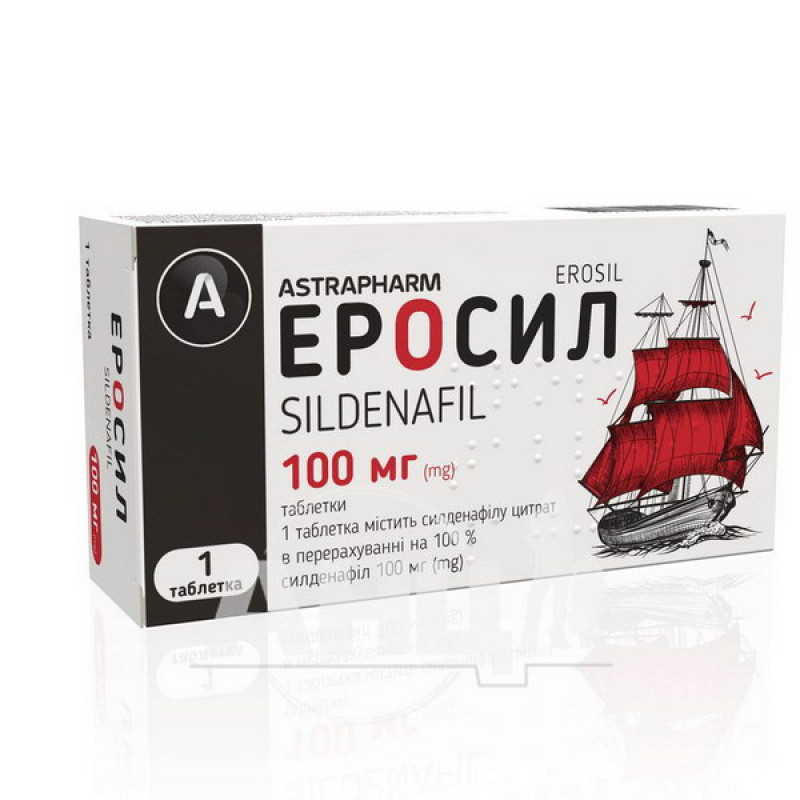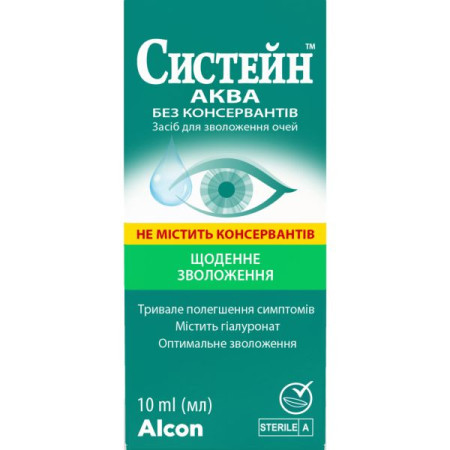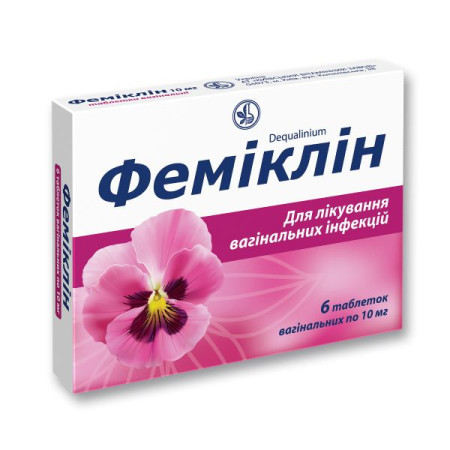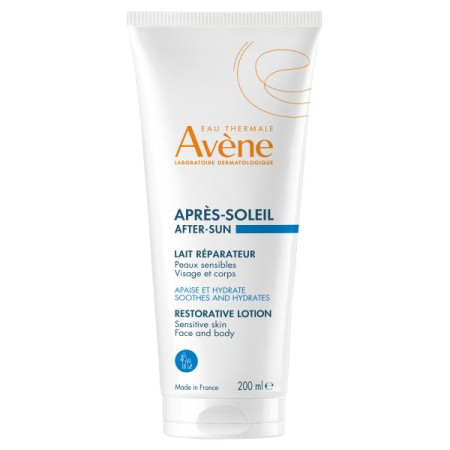Erosil tablets 100 mg blister No. 1

Translation of the instructions can be
Eros tablets 50 mg, tablets 100 mgInstruction
Eros
(Erosil)
Composition:
Active ingredient: sildenafil;
1 tablet contains sildenafil citrate equivalent to 100% sildenafil 50 mg;
excipients: lactose monohydrate; magnesium gluconate; powdered sugar; calcium stearate; lemon flavoring; tartrazine dye (E 102).
Main physicochemical properties: biconvex yellow tablets with a score line on one side and the company logo on the other.
Dosage form.
Pills.
50 mg #1, 50 mg #2, 50 mg #4;
100 mg #1, 100 mg #2, 100 mg #4.
Pharmacotherapeutic group.
Drugs used for erectile dysfunction. sildenafil.
PBX code G04B E03.
Pharmacological properties.
Pharmacodynamics.
Mechanism of action. Eros is an oral drug used to treat erectile dysfunction in men. The drug is the citrate salt of sildenafil, a selective inhibitor of cyclic guanosine monophosphate (cGMP)-specific phosphodiesterase type 5 (PDE5).
The physiological mechanism of penile erection is the release of nitric oxide (NO) in the corpus cavernosum during sexual stimulation. NO activates the enzyme guanylate cyclase, which causes an increase in the level of cyclic guanosine monophosphate (cGMP), relaxation of the smooth muscles of the corpus cavernosum and increased blood flow to them.
Sildenafil does not have a direct relaxing effect on the isolated human corpus cavernosum, but enhances the effectiveness of nitric oxide (NO) by inhibiting phosphodiesterase type 5 (PDE5), which is responsible for the degradation of cGMP in the corpus cavernosum.
When sexual stimulation results in local release of NO, sildenafil inhibition of PDE5 causes an increase in cGMP levels in the corpus cavernosum, resulting in smooth muscle relaxation and increased blood flow to the corpus cavernosum.
The use of sildenafil in recommended doses is ineffective in the absence of sexual arousal.
Pharmacodynamic effects. In vitro studies have shown that sildenafil is selective for PDE5. Its effect on PDE5 is stronger than that of other known phosphodiesterases (10 times stronger than PDE6, 80 times stronger than PDE1, 700 times stronger than PDE2, PDE3, PDE4, PDE7 - PDE11). In particular, sildenafil has a 400-fold better selectivity for PDE5 than for PDE3, a cGMP-specific isoform of phosphodiesterase involved in the regulation of heart rate.
Visual disturbances. When using sildenafil at a dose of 100 mg, some patients experienced a slight transient disturbance of color discrimination (blue/green) after 1 hour (using the Farnsworth-Munsell 100 test); these changes disappeared 2 hours after taking the drug.
The probable mechanism of color vision impairment is considered to be inhibition of PDE6, which is involved in the process of light transmission in the retina. In vitro studies show that the effect of sildenafil on PDE6 is 10 times less than its activity on PDE5. Sildenafil does not affect visual acuity, contrast perception, electroretinograms, intraocular pressure, or pupillometry.
Efficacy. The efficacy of sildenafil, assessed in terms of the drug's ability to achieve and maintain an erection sufficient for sexual intercourse, has been demonstrated and maintained with long-term use of the drug (1 year).
In the study, sildenafil at doses of 25 mg, 50 mg, and 100 mg improved erections in 62%, 74%, and 82%, respectively. In addition to improving erectile function, an analysis of the International Index of Erectile Function (IIEF) showed that sildenafil treatment also increased orgasm and sexual satisfaction.
When treated with sildenafil, improvement was observed in 59% of patients with diabetes mellitus; in patients who underwent radical prostatectomy - 43%, in patients with spinal cord injury - 83%.
Pharmacokinetics.
Sildenafil is rapidly absorbed. Peak plasma concentrations are achieved within 30-120 minutes (median 60 minutes) after oral administration in the fasted state. The mean absolute oral bioavailability is 41% (range 25-63%). Over the recommended dose range (25-100 mg), the AUC and Cmax of sildenafil increase in proportion to the dose after oral administration.
When sildenafil is taken with food, the extent of absorption is reduced with a mean prolongation of Tmax to 60 minutes and a mean decrease in Cmax by 29%.
The average equilibrium volume of distribution (Vd) is 105 l, which indicates the distribution of the drug in the tissues of the body. After a single oral administration of sildenafil at a dose of 100 mg, the average maximum total plasma concentration of sildenafil is approximately 440 ng / ml (the coefficient of variation is 40%). Since the binding of sildenafil and its main N-desmethyl metabolite to plasma proteins reaches 96%, the average maximum plasma concentration of free sildenafil reaches 18 ng / ml (38 nmol). The degree of binding to plasma proteins does not depend on the total concentrations of sildenafil.
Biotransformation. Sildenafil is metabolized primarily by the hepatic microsomal isoenzymes CYP3A4 (major pathway) and CYP2C9 (minor pathway). The major circulating metabolite is formed by N-demethylation of sildenafil. The selectivity of the metabolite for PDE5 is comparable to that of sildenafil, and the activity of the metabolite for PDE5 is approximately 50% of that of the parent compound. Plasma concentrations of this metabolite are approximately 40% of those of sildenafil in plasma. The N-demethylated metabolite undergoes further metabolism and has a half-life of approximately 4 hours.
The total clearance of sildenafil is 41 l/h, resulting in a half-life of 3-5 hours. After both oral and intravenous administration, sildenafil is excreted as metabolites mainly in the feces (approximately 80% of the administered oral dose) and, to a lesser extent, in the urine (approximately 13% of the administered oral dose).
Elderly patients: In healthy elderly volunteers (aged 65 years and older), a decrease in sildenafil clearance was observed, which resulted in an increase in plasma concentrations of sildenafil and its active N-demethylated metabolite by approximately 90% compared with the corresponding concentrations in healthy younger volunteers (18-45 years). Due to age-related differences in plasma protein binding, the corresponding increase in plasma concentrations of free sildenafil was approximately 40%.
Renal impairment. In volunteers with mild to moderate renal impairment (creatinine clearance 30 to 80 ml/min), the pharmacokinetics of sildenafil were unchanged after a single oral dose of 50 mg. The mean AUC and Cmax of the N-demethylated metabolite were increased by 126% and 73%, respectively, compared with those in age-matched volunteers without renal impairment. However, due to high interindividual variation, these differences were not statistically significant. In volunteers with severe renal impairment (creatinine clearance below 30 ml/min), sildenafil clearance was reduced, resulting in mean increases in AUC and Cmax of 100% and 88%, respectively, compared with age-matched volunteers without renal impairment. In addition, the AUC and Cmax values of the N-demethylated metabolite were significantly increased by 79% and 200%, respectively.
Hepatic impairment: In volunteers with mild to moderate cirrhosis (Child-Pugh class A and B), sildenafil clearance was reduced, resulting in increased AUC (84%) and C max (47%) compared to age-matched volunteers without hepatic impairment. The pharmacokinetics of sildenafil in patients with severe hepatic impairment have not been studied.
Clinical characteristics.
Indication.
Treatment of erectile dysfunction, defined as the inability to achieve and maintain a penile erection necessary for successful sexual intercourse.
For Eros to work effectively, sexual arousal is required.
Contraindication.
- hypersensitivity to the active substance or any of the excipients of the drug.
- Concomitant use with nitric oxide donors (such as amyl nitrite) or nitrates in any form is contraindicated, as sildenafil is known to affect the nitric oxide/cyclic guanosine monophosphate (cGMP) metabolic pathway and potentiates the hypotensive effect of nitrates.
- Conditions in which sexual activity is not recommended (e.g. severe cardiovascular disorders such as unstable angina or severe heart failure).
- Loss of vision in one eye as a result of non-arterial anterior ischemic optic neuropathy, regardless of whether this pathology is associated with previous use of PDE5 inhibitors or not.
- The presence of diseases such as severe liver dysfunction, arterial hypotension (blood pressure below 90/50 mm Hg), recent stroke or myocardial infarction and known hereditary degenerative retinal diseases such as retinitis pigmentosa (a small number of such patients have genetic disorders of retinal phosphodiesterases), since the safety of sildenafil has not been studied in such subgroups of patients.
Interaction with other drugs and other types of interactions.
Effects of other drugs on sildenafil.
In vitro studies.
Sildenafil metabolism occurs predominantly with the participation of the 3A4 isoform (major pathway) and 2C9 isoform (minor pathway) of cytochrome P450 (CYP), therefore inhibitors of these isoenzymes can reduce sildenafil clearance, and inducers of these isoenzymes can increase sildenafil clearance.
In vivo studies.
Co-administration of the HIV protease inhibitor ritonavir, a very potent P450 inhibitor, at steady state (500 mg once daily) with sildenafil (single dose of 100 mg) resulted in a 300% (4-fold) increase in sildenafil Cmax and a 1000% (11-fold) increase in sildenafil AUC. After 24 hours, plasma sildenafil levels were still approximately 200 ng/mL compared to approximately 5 ng/mL when sildenafil was administered alone, consistent with the significant effect of ritonavir on a broad spectrum of P450 substrates. Sildenafil does not affect the pharmacokinetics of ritonavir. Based on these pharmacokinetic data, co-administration of sildenafil and ritonavir is not recommended; In any case, the maximum dose of sildenafil should not exceed 25 mg within 48 hours under any circumstances.
Co-administration of the HIV protease inhibitor saquinavir, a CYP3A4 inhibitor, at a steady-state dose (1200 mg three times daily) with sildenafil (100 mg once daily) resulted in a 140% increase in sildenafil Cmax and a 210% increase in sildenafil systemic exposure (AUC). Sildenafil did not appear to have an effect on the pharmacokinetics of saquinavir. More potent CYP3A4 inhibitors, such as ketoconazole and itraconazole, are expected to have a more pronounced effect.
When sildenafil (100 mg once) was administered with erythromycin, a moderate CYP3A4 inhibitor, at steady state (500 mg twice daily for 5 days), a 182% increase in sildenafil systemic exposure (AUC) was observed. In healthy male volunteers, there was no effect of azithromycin (500 mg daily for 3 days) on the AUC, C max , T max , elimination rate constant, and subsequent half-life of sildenafil or its major circulating metabolite. Cimetidine (a cytochrome P450 inhibitor and nonspecific CYP3A4 inhibitor) at a dose of 800 mg when co-administered with sildenafil at a dose of 50 mg in healthy volunteers resulted in a 56% increase in plasma concentrations of sildenafil.
Grapefruit juice is a weak inhibitor of CYP3A4 in the intestinal wall and may cause a modest increase in plasma levels of sildenafil.
Single administration of antacids (magnesium hydroxide/aluminum hydroxide) does not affect the bioavailability of sildenafil.
Although specific drug interaction studies have not been conducted, population pharmacokinetic analysis suggests that sildenafil pharmacokinetics were not altered by concomitant use of drugs that belong to the CYP2C9 inhibitor group (tolbutamide, warfarin, phenytoin), CYP2D6 inhibitor group (such as selective serotonin reuptake inhibitors, tricyclic antidepressants), thiazide and thiazide-like diuretics, loop and potassium-sparing diuretics, angiotensin-converting enzyme inhibitors, calcium antagonists, β-blockers, or inducers of CYP450 metabolism (such as rifampicin, barbiturates).
Co-administration of the endothelin antagonist bosentan (a moderate inducer of CYP3A4, CYP2C9 and possibly CYP2C19) at steady state (125 mg twice daily) with sildenafil at steady state (80 mg three times daily) has been reported to result in a 62.6% and 55.4% decrease in sildenafil AUC and Cmax, respectively. Therefore, co-administration of potent CYP3A4 inducers such as rifampin may result in a more pronounced decrease in sildenafil plasma concentrations.
Nicorandil is a hybrid of a calcium channel activator and a nitrate. The nitrate component makes it possible for it to have a serious interaction with sildenafil.
Effects of sildenafil on other drugs.
In vitro studies.
Sildenafil is a weak inhibitor of cytochrome P450 isoforms 1A2, 2C9, 2C19, 2D6, 2E1 and 3A4 (IC50 150 μmol). Since peak plasma concentrations of sildenafil are approximately 1 μmol, sildenafil is unlikely to affect the clearance of substrates of these isoenzymes.
There are no data on the interaction of sildenafil and non-specific phosphodiesterase inhibitors such as theophylline and dipyridamole.
In vivo studies.
Since sildenafil is known to have an effect on nitric oxide/cyclic guanosine monophosphate (cGMP) metabolism, it has been found that this drug potentiates the hypotensive effect of nitrates, therefore its simultaneous use with nitric oxide donors or with nitrates in any form is contraindicated.
No significant interactions were observed with the simultaneous use of sildenafil (50 mg) and tolbutamide (250 mg) or warfarin (40 mg), which are metabolized by CYP2C9.
Sildenafil (50 mg) did not prolong bleeding time induced by acetylsalicylic acid (150 mg).
Sildenafil (50 mg) potentiated the hypotensive effect of alcohol in healthy volunteers at mean maximum blood ethanol levels of 80 mg/dl.
In patients taking sildenafil, no differences in the side effect profile were observed compared to placebo when using such classes of antihypertensive drugs as diuretics, β-blockers, ACE inhibitors, angiotensin II antagonists, antihypertensive drugs (vasodilators and centrally acting), adrenergic neurone blockers, calcium channel blockers and α-adrenergic blockers. In a special interaction study, when sildenafil (100 mg) was used concomitantly with amlodipine in patients with arterial hypertension, an additional reduction in supine systolic blood pressure of 8 mm Hg was observed.
The corresponding reduction in diastolic blood pressure was 7 mmHg. The magnitude of these additional reductions in blood pressure was comparable to those observed with sildenafil alone in healthy volunteers.
Sildenafil at a dose of 100 mg did not affect the pharmacokinetics of the HIV protease inhibitors, saquinavir and ritonavir, which are CYP3A4 substrates.
It is known that the use of sildenafil at steady state (80 mg three times a day) increased the AUC and Cmax of bosentan (125 mg twice a day) by 49.8% and 42%, respectively.
Application features.
Before starting therapy, the patient's medical history should be collected and a physical examination should be performed to diagnose erectile dysfunction and determine its possible causes.
Cardiovascular risk factors. Since sexual activity carries a certain cardiac risk, the physician should assess the patient's cardiovascular status before initiating any treatment for erectile dysfunction. Sildenafil has a vasodilating effect, which is manifested by a mild and transient decrease in blood pressure. Before prescribing sildenafil, the physician should carefully consider whether this effect may have an adverse effect on patients with certain underlying diseases, especially in combination with sexual activity. Patients with increased sensitivity to vasodilators include patients with obstruction of the outflow tract of the left ventricle (e.g. aortic stenosis, hypertrophic obstructive cardiomyopathy) or patients with the rare syndrome of multiple system atrophy, one of the manifestations of which is severe dysregulation of blood pressure by the autonomic nervous system.
Sildenafil potentiates the hypotensive effect of nitrates.
Serious cardiovascular adverse reactions, including myocardial infarction, unstable angina, sudden cardiac death, ventricular arrhythmia, cerebrovascular hemorrhage, transient ischemic attack, hypertension, and hypotension, have been reported in association with sildenafil use. Most, but not all, patients had cardiovascular risk factors. Many of these adverse reactions occurred during or shortly after sexual intercourse, and only a few occurred shortly after sildenafil use in the absence of sexual activity. Therefore, it is not possible to determine whether these adverse reactions are directly related to the risk factors or whether they are caused by other factors.
Priapism: Erectile dysfunction drugs, including sildenafil, should be prescribed with caution in patients with anatomical deformities of the penis (such as angulation, cavernosal fibrosis, or Peyronie's disease) or in patients with conditions that predispose to priapism (such as sickle cell anemia, multiple myeloma, or leukemia).
Cases of prolonged erection and priapism have been reported. If an erection lasts more than 4 hours, patients should seek immediate medical attention. If not treated promptly, priapism can lead to damage to penile tissue and permanent loss of potency.
Concomitant use with other PDE5 inhibitors or other drugs for the treatment of erectile dysfunction. The safety and efficacy of concomitant use of sildenafil with other PDE5 inhibitors or other drugs for the treatment of pulmonary arterial hypertension that contain sildenafil (e.g. Revatio), or with other drugs for the treatment of erectile dysfunction have not been studied. Therefore, the use of such combinations is not recommended.
Concomitant use with ritonavir: Concomitant use of sildenafil and ritonavir is not recommended (see section 4.5).
Concomitant use with α-adrenergic blockers. Sildenafil should be used with caution in patients taking α-adrenergic blockers, as the combination may lead to symptomatic hypotension in some susceptible patients. Symptomatic hypotension usually occurs within 4 hours of sildenafil administration. In order to minimize the risk of orthostatic hypotension, sildenafil therapy should only be initiated in hemodynamically stable patients taking α-adrenergic blockers. The recommended starting dose in such patients is 25 mg sildenafil. In addition, patients should be informed of what to do if symptoms of orthostatic hypotension occur.
Effects on bleeding. Studies in human platelets have shown that sildenafil potentiates the antiplatelet effects of sodium nitroprusside in vitro. There is no information on the safety of sildenafil in patients with coagulation disorders or acute peptic ulcer disease. Therefore, sildenafil should only be used in these patients after careful benefit-risk assessment.
The drug Eros contains lactose, so it should not be used by men with rare hereditary disorders such as galactose intolerance, Lapp lactase deficiency or glucose-galactose malabsorption.
Hearing loss. Physicians should advise patients to discontinue use of PDE5 inhibitors, including Eros, and to seek immediate medical attention if they experience sudden hearing loss or hearing loss. These events, which may also be accompanied by tinnitus and dizziness, have been reported in temporal association with the use of PDE5 inhibitors, including Eros. It is not possible to determine whether these events are directly related to the use of PDE5 inhibitors or to other factors.
Concomitant use with antihypertensive drugs. Eros has a systemic vasodilator effect and may further reduce blood pressure in patients taking antihypertensive drugs. In a separate drug interaction study, simultaneous use of amlodipine (5 mg or 10 mg) and the drug Eros (100 mg) orally resulted in an average additional decrease in blood pressure of 8 mm Hg systolic and 7 mm Hg diastolic.
Sexually transmitted diseases. Use of Eros does not protect against sexually transmitted diseases. Consideration should be given to instructing patients on the necessary precautions to protect against sexually transmitted diseases, including human immunodeficiency virus.
Use during pregnancy or breastfeeding.
The drug is not intended for use by women.
The ability to influence the reaction speed when driving or working with other mechanisms.
Studies on the effect of the drug on the ability to drive a car or operate other mechanisms have not been conducted.
Since dizziness and visual disturbances were observed during clinical studies of sildenafil, patients need to be aware of their individual reaction to taking Eros before driving or operating other machinery.
Method of administration and doses.
The drug is administered orally.
Adults. The recommended dose of the drug is 50 mg and is used if necessary approximately one hour before sexual activity. Depending on the effectiveness and tolerability of the drug, the dose can be increased to 100 mg or reduced to 25 mg. The maximum recommended dose is 100 mg. The frequency of use of the maximum recommended dose of the drug is 1 time per day. When the drug is used with food, the effect of the drug may occur later than when it is used on an empty stomach.
Elderly patients: No dose adjustment is required for elderly patients (≥ 65 years).
Patients with renal impairment. For patients with mild to moderate renal impairment (creatinine clearance 30-80 ml/min), the recommended dose is the same as given above in the Adults section.
Since in patients with severe renal insufficiency (creatinine clearance
Patients with hepatic impairment. Since sildenafil clearance is reduced in patients with hepatic impairment (e.g. cirrhosis), a dose of 25 mg should be considered. Depending on efficacy and tolerability, the dose may be increased gradually to 50 mg and 100 mg if necessary.
To minimise the potential for postural hypotension in patients taking α-blockers, their condition should be stabilised with α-blockers before starting sildenafil. A starting dose of 25 mg should also be considered (see sections 4.4 and 4.5).
Children.
The drug is not indicated for use by persons under the age of 18.
Overdose.
When using a single dose of sildenafil up to 800 mg, adverse reactions were similar to those observed with the use of sildenafil in lower doses, but were more frequent and severe. The use of sildenafil at a dose of 200 mg did not lead to an increase in efficacy, but caused an increase in the number of cases of adverse reactions (headache, flushing, dizziness, dyspepsia, nasal congestion, visual disturbances).
In case of overdose, usual supportive measures should be used if necessary.
Acceleration of sildenafil clearance during hemodialysis is unlikely due to the high degree of binding of the drug to plasma proteins and the lack of elimination of sildenafil in the urine.
Adverse reactions.
The most common side effects are headache, flushing, dyspepsia, nasal congestion, back pain, dizziness, nausea, hot flashes, visual disturbances, cyanopsia, and blurred vision.
Infectious and invasive diseases: rhinitis.
Immune system disorders: hypersensitivity.
From the nervous system: headache, dizziness, drowsiness, hypoesthesia, stroke, transient ischemic attack, seizures, recurrent seizures, syncope.
On the part of the organs of vision: color perception disorders, visual disorders, blurred vision, lacrimation disorders, eye pain, photophobia, photopsia, ocular hyperemia, visual brightness, conjunctivitis, non-arterial anterior ischemic optic neuropathy, retinal vascular occlusion, retinal hemorrhage, arteriosclerotic retinopathy, retinal disorders, glaucoma, visual field defects, diplopia, decreased visual acuity, myopia, asthenopia, floating vitreous opacities, iris disorders, mydriasis, the appearance of luminous circles around the light source (halo) in the field of vision, eye edema, eye swelling, eye disorders, conjunctival hyperemia, eye irritation, abnormal sensations, eyelid edema in the eyes, sclera discoloration.
On the part of the organs of hearing: tinnitus, deafness.
Cardiovascular system: tachycardia, palpitations, sudden cardiac death, myocardial infarction, ventricular arrhythmia, atrial fibrillation, unstable angina, facial flushing, hot flashes, hypertension, hypotension.
Respiratory, thoracic and mediastinal disorders: nasal congestion, epistaxis, sinus congestion, feeling of tightness in the throat, swelling of the nasal mucosa, dry nose.
Gastrointestinal: nausea, dyspepsia, gastroesophageal reflux disease, vomiting, upper abdominal pain, dry mouth, oral hypoesthesia.
Skin and subcutaneous tissue disorders: rash, Stevens-Johnson syndrome, toxic epidermal necrolysis.
Musculoskeletal and connective tissue disorders: myalgia, pain in the extremities.
From the urinary system: hematuria.
Reproductive system and breast disorders: penile bleeding, priapism, hematospermia, prolonged erection.
General disorders: chest pain, fatigue, feeling hot, irritability.
Disorders detected as a result of the examination: increased heart rate.
Expiration date.
3 years.
Storage conditions.
Store in original packaging at a temperature not exceeding 25 degrees Celsius.
Keep out of reach of children.
Packaging.
2 or 4 tablets in a blister; 1 blister in a box.
Vacation category.
According to the recipe.
Producer.
Location of the manufacturer and address of its place of business.
Ukraine, 08132, Kyiv region, Kyiv-Svyatoshynskyi district, Vyshneve, Kyivska st., 6.
There are no reviews for this product.
There are no reviews for this product, be the first to leave your review.
No questions about this product, be the first and ask your question.













